
by Eladrin
Saddle up, everyone! It’s time to go a-ranchin’!
The Vivarium of the Grand Archive will be accepting genetic material donations as of October 29th.
Today we’re looking at the capture and domestication of spaceborne fauna, Domestication traditions, and the Beastmaster civics. Let’s get to it, this is a long one!
The Vivarium is essentially a space fauna breeding and observation tank. You can access it under Discoveries as soon as your Vivarium capacity is above zero or the Gravity Snares technology has been researched.
The Hatchery module is the space fauna equivalent of Shipyards, and can only be built on a station that has no normal Shipyards. It’s unlocked by the Artificial Breeding technology.
You can also increase your capacity by building Vivarium Tanks. These increase the growth rate of your docked fauna and are unlocked by the Gravity Snares technology. Building a Grand Archive will give you the biggest boost to Vivarium capacity.

This particular Vivarium isn’t terribly interesting yet though. We need to find some friends!
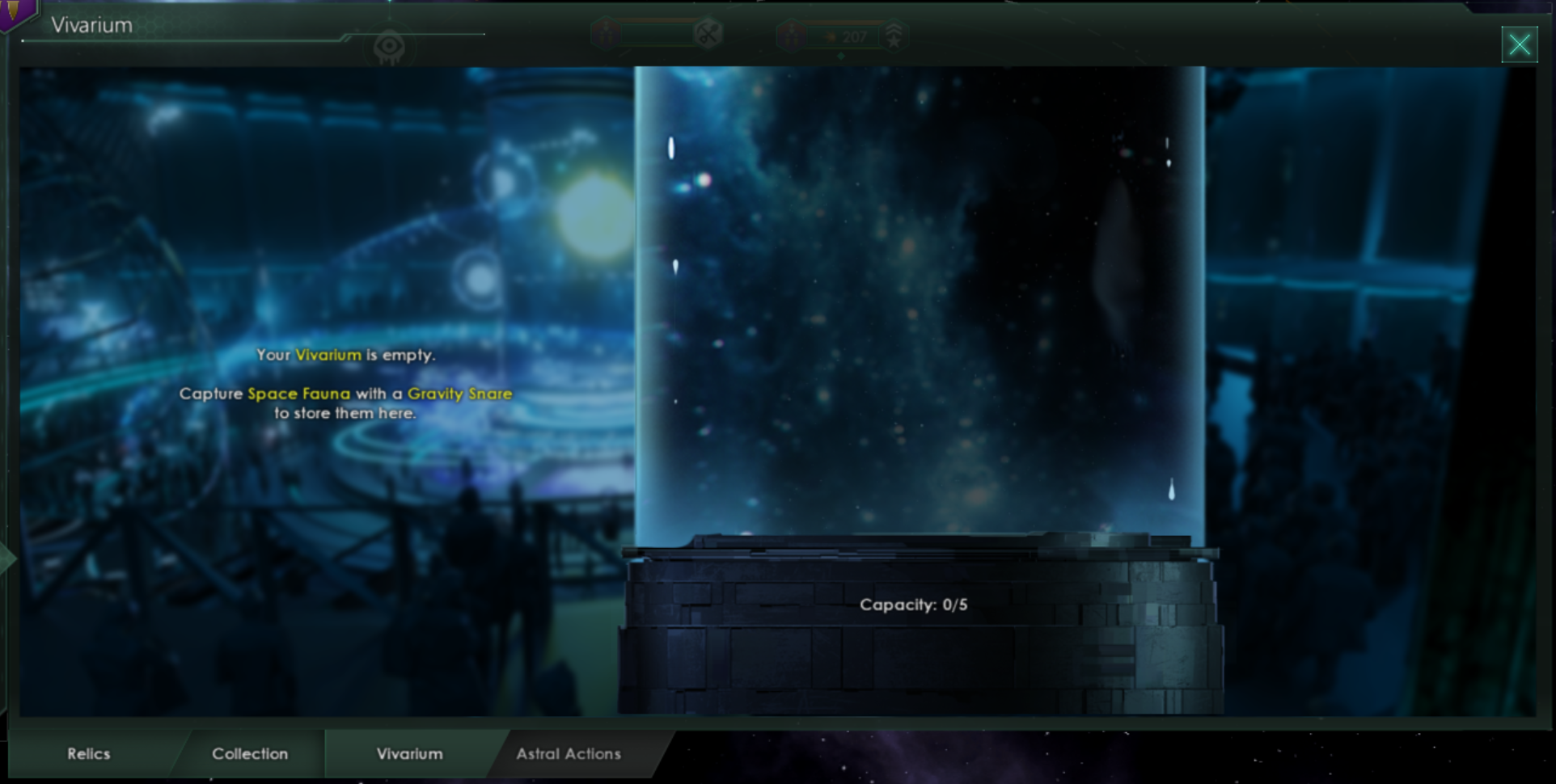
I also won’t be able to fit much in this Vivarium. I should build a Grand Archive and some supplemental Tanks.
The Gravity Snares technology lets your science ships attempt to capture wild Space Fauna.
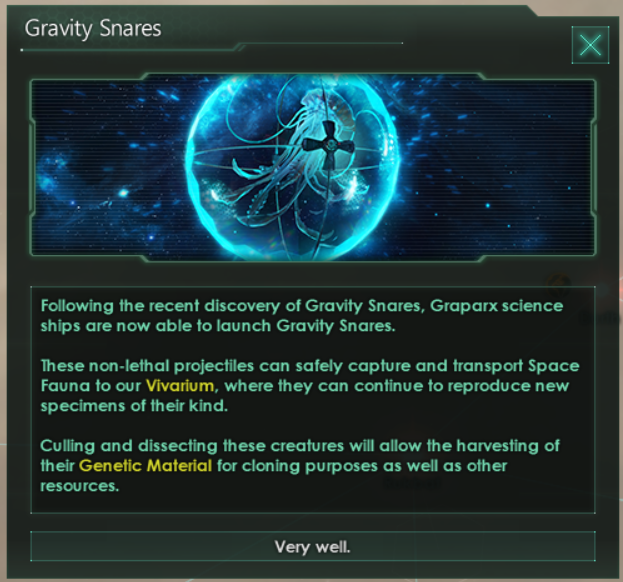
Oh yeah, culling and dissecting also happens at the Vivarium.
You can launch a Gravity Snare from an adjacent system to attempt to capture wild space fauna that are peacefully… Actually, to be honest, those are Crystalline Entities and there’s nothing peaceful about them. While I bet they’d make a good addition to our fleet, I said we should find some friends so let’s go get some Tiyanki instead.
You need to know the basics about the creature before being able to tune the Gravity Snares appropriately, so you’ll have to finish the first contact process before you can capture them. There’s a cost and a cooldown to capture attempts, and as you unlock various technologies, the capture chance and the number that you can capture at once will increase. Other technologies like Cloaking and Jump Drives will also improve your Gravity Snares – the first increases their capture rate, the second lets them instantly send your new friend to your vivarium instead of taking a little while to transfer them.

We’ve added Capture Space Fauna to Science Ship Automation Settings too.
The Gravity Snare will fly to the adjacent system and attempt to capture their target. It will generally attempt to capture random breeding age adults if there are any in the target group.


Success! We done caught ourselves a common Tiyanki cow! Since she’s cruiser sized, she takes up 4 of our Vivarium capacity, and is very, very lonely.
Space fauna inside the Vivarium grow at an accelerated rate. Life is easy when you’re being fed by advanced alien ranchers, and the only worry you have is that “Cull” button.

By the way, “Auto-Culling” is the most “Stellaris” button ever created.
We could use a few more. Space fauna have growth stages and breeding requirements that vary by species. For example, Tiyanki require a mating partner, Crystals and Amoebas reproduce asexually, and Voidworms… They’re special. I’ll talk more about them next week.
Ti’yan’ek needs another Tiyanki to breed. We could fly around trying to find them, or we can bring them to us with a Voidlure. Voidlures are a Starbase building (unlocked by completing the Domestication traditions) that attract a specific species of space fauna, and must be built in their favored habitat. (Space Amoebas like Nebulas, Crystalline Entities like Pulsars, and so on.)

Every month there’s a chance that any captive fauna that can breed will automatically do so, which will put them on a cooldown before they can reproduce again. This will be visible under “Reproductive Status”.
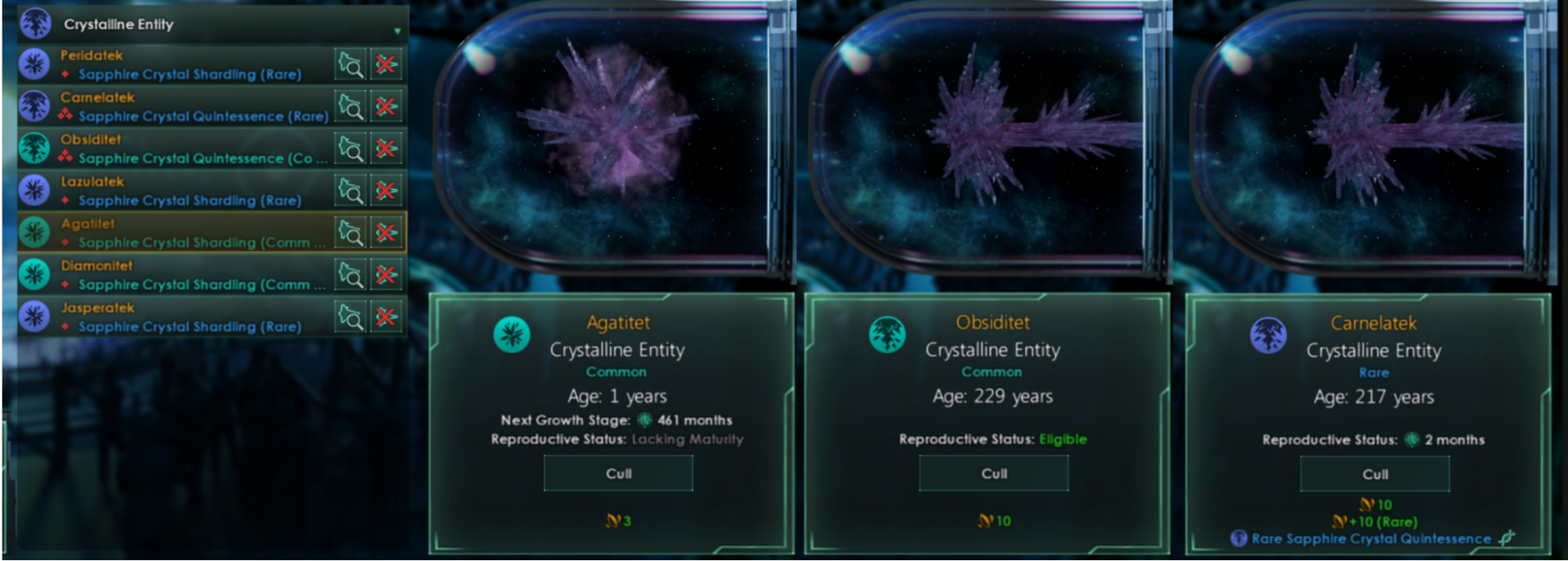
My collection of Crystals
Culling fauna will provide resources (which varies depending on the species) as well as their genetic material. Having a creature’s genetic material allows you to grow clones of them at your Hatchery. Exceptional creatures (marked by their rarity) have increased combat stats and culling rewards. Cloned fauna will always use the highest rarity available, and you can upgrade existing fleets if you acquire
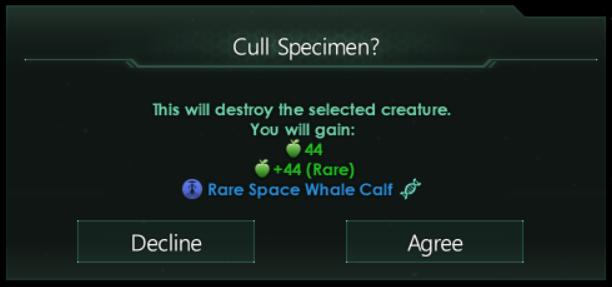
Sorry buddy, I need you for parts.
Generally you’ll clone fauna at the smallest size and they’ll grow up over time, but technologies exist that will let you force-grow them to start at a larger growth stage.

Ship tooltips will let you know how long it is until they’ll reach their next growth stage.
Since larger space fauna take up more Naval Capacity, there are times that you may want to prevent their growth – you can prevent them from exceeding the command limit of a fleet by changing their Growth Stance. You can also block them from exceeding your overall Naval Capacity in policies.

The Controlled Mutations technology lets you make some changes to the fauna you have captured when you’re creating clones. This lets you use a variant of the Ship Designer to “redesign” them and make use of special mutation component slots.
Space fauna Mutations are tied to other technologies, but won’t clutter the tooltips unless you have Controlled Mutations.

I’m pretty sure that Space Amoeba needs LASER EYES.
Mutations can be broadly classified as Offensive, Defensive, or Special, but you can freely use those slots however you want to customize your Fauna. (Barring restrictions on the components themselves, like how you can still only have one Cloaking mutation.) You can alter their behavior (in a way similar to combat computers) by installing neurochips.
The different space fauna have different resource costs and upkeeps, and those upkeep costs are reduced if they’re in their preferred habitat.
You can (and probably should) also create designs for what your Fauna will grow into if you allow them to. You can change the current growth stage by clicking on the “Pick Creature Size” button.
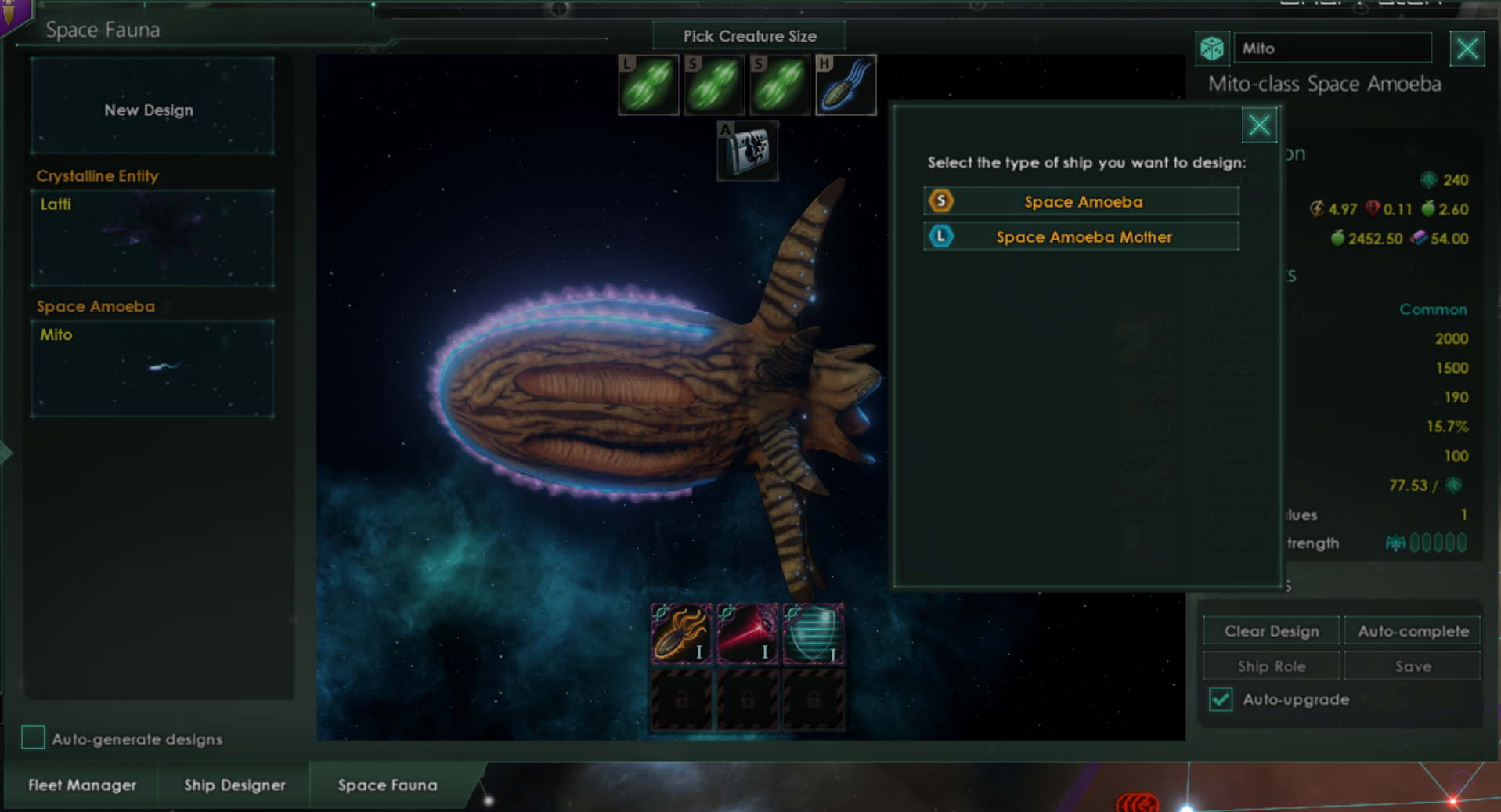
The Domestication Traditions can be taken once you have the Artificial Breeding technology. It’s focused, as one might expect, on improving your space fauna.


The Metabolic Regulation policy allows you to increase fauna growth rate and upkeep, or freeze their growth but reduce upkeep.
As with the Galactic Curator civics, if you want to go all-in on space beasties, you can take one of the Beastmaster civics. These civics dramatically increase the upkeep of artificial ships, but give you everything you’ll need to fully embrace the rancher life.

Beastmasters replace their Hatcheries and Shipyards with dual-use Beastports. These can clone space fauna like a Hatchery but also have rudimentary shipbuilding capabilities and are able to build civilian vessels, so you won’t need to keep a shipyard around just for your colony, construction, and science ships.
While this space fauna breeding system scratches a lot of the “bio-ship” itch, we don’t consider them exactly the same systems. These are more like vicious mutated pets than meat-ships you fly around in. Expect that one day in the future we’ll explore that idea.
Next week we’ll be examining the new lifeforms in the galaxy and the two new origins.
See you then!

